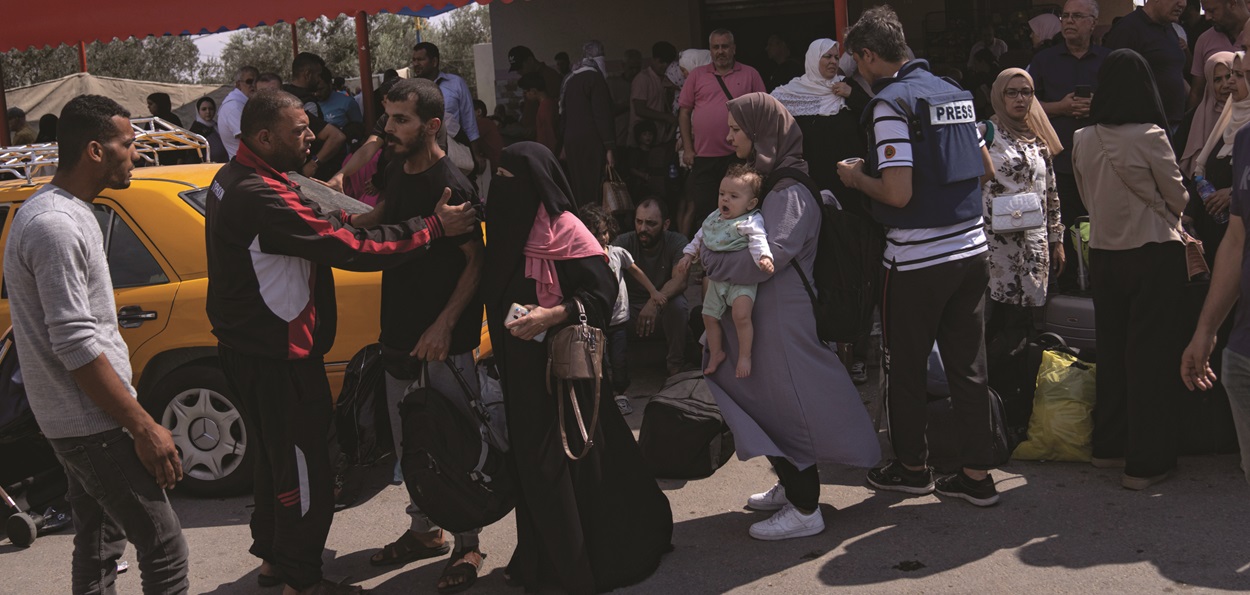
Determined not to let a crisis go to waste, some of the most militaristic elements of the Israeli political establishment are pushing a plan for the “resettlement” and “final rehabilitation” of the entire Gaza population to Egypt.
The scheme is being circulated among the Israeli policy establishment by the Misgav Institute for National Security and Zionist Strategy, a think tank headed by Meir Ben Shabbat. He was previously Prime Minister Benjamin Netanyahu’s National Security Advisor and is a 30-year veteran of the Shabak, Israel’s secret police agency.
Though not widely known outside Israel, Misgav was founded a decade ago, according to Yehuda Mirsky, Brandeis University professor and former U.S. State Department official, to “provide a more hawkish stance in Israel’s policy community.”
It is reportedly funded, at least in part, by the influential Kohelet Forum, one of the driving forces behind Israel’s Jewish Nation-State law and Netanyahu’s judicial coup. Kohelet was founded by U.S.-Israeli billionaire Moshe Koppel, who said he established it to overcome “Israel’s legacy of socialist economics.” Koppel currently lives as a settler in the occupied West Bank.

In the Misgav paper, titled “A Plan for the Resettlement and Final Rehabilitation in Egypt of the Entire Population of Gaza,” author Amir Weitmann lays out the economic case for Israel to fully clear the Gaza Strip of all its Palestinian residents.
Weitmann is a member of the Israeli Knesset and head of the free market liberal wing of Netanyahu’s Likud Party. The position paper put out by Misgav refers to him as an “investment manager and visiting researcher.” He is head of Champel Capital, a tech-focused venture capital fund.
Weitmann became known to millions of global social media users late last week after video of a recent appearance by him on the Russia Today television network went viral. In the interview, he berates a news host and threatens that “Russia will pay the price” for “supporting the enemies of Israel.” He declared that after Israel wins its war against the Palestinians, “We will make sure that Ukraine wins.”
In the meantime, however, Weitmann is focused on Gaza.
In his Misgav paper, he says the Israeli government must take advantage of the international sympathy it currently enjoys among Western allies following the Hamas attacks of Oct. 7 to do what is politically impossible under normal circumstances.
In the opening of the policy paper and in a tweet posted by Misgav, Weitmann says, “There is currently a unique and rare opportunity to evacuate the entire Gaza Strip” and ship out “the entire Arab population” for good.
Richard Silverstein, known for exposing the secrets of the Israeli security state on his Tikun Olam blog, said that the language in Weitmann’s proposal recalls the terminology of the Third Reich. He characterized it as “an Israeli form of the Final Solution of the Gaza Problem.’”
The economics of ethnic cleansing
The paper backs up its position with a detailed analysis of the housing market in Egypt and the reasons why it is viable for that country to take all of the Palestinians in Gaza that Israel wants moved out.
A translation of the Misgav summary points out that there are approximately “10 million vacant housing units in Egypt…a huge amount of built and empty apartments owned by the government” and private construction companies. Weitmann estimates they are “sufficient to house about 6 million inhabitants.”
The analysis continues, examining the costs involved if Israel were to start buying up the empty units.
“The average cost of a 3-room apartment with an area of 95 square meters for an average Gazan family consisting of 5.14 people” in the suburbs of Cairo “is about $19,000.” Taking into account the whole population of Gaza—estimated to be between 1.4 to 2.2 million people, “it can be estimated that the total amount that will be required to be transferred to Egypt to finance the project will be on the order of 5 to 8 billion dollars.”
Resettlement is pitched as a boon for Egypt’s struggling economy, and Weitmann argues that sweetening the pot with extra financial incentives may be enough to convince dictator Abdel Fattah al-Sisi to drop his opposition to the expulsion of Gazans.
“Throwing an immediate stimulus…to the Egyptian economy would provide a tremendous and immediate benefit to al-Sisi’s regime,” while the costs to the Israeli economy would be minimal. “Investing a few billion dollars (even if it is 20 to 30 billion dollars) to solve this difficult issue is an innovative, cheap, and sustainable solution.”
The analysis is methodical and almost bureaucratic, turning the ethnic cleansing of the Palestinian people from Gaza into a detached economic treatise.
The Weitmann document is just one of a number of statements distributed by Misgav and its top figures in recent days advocating the total expulsion of Palestinians from Gaza.
In another, by Raphael BenLevi, a former IDF Intelligence officer, Misgav argues that the only viable solution for Israeli security is to “transfer the Gaza population to Sinai [Egypt] or other countries.”
BenLevi says that the U.S. can play a crucial role in pressuring Egypt, Turkey, and other nations to take the unwanted Palestinians and help justify the forced displacement as “self-defense” rather than the war crime that international law says it is.

Meir Ben Shabbat, head of the institute, dispensed with the detached analytical talk employed by Weitmann and BenLevi and instead opted for more brutal language in an op-ed published Friday in the nationalistic Israel Hayom newspaper.
In it, he says Israel must follow the strategy the U.S. military used in its campaign against ISIS in Iraq and Syria in 2016 and 2017—“a war of annihilation.”
He said that 80% of the Syrian city of Raqqa was made “unsuitable for human habitation” by U.S. forces, and argued that Israel must do the same in Gaza. Looking to the total devastation of Mosul, Iraq, by the U.S., he approvingly recalled the firebombing of Dresden, Germany, during World War II, which completely flattened that city.
The Misgav leader says that to deal with Hamas, state authorities must lift “various constraints” associated with avoiding civilian casualties. Choosing between international law and supporting the Israeli military’s efforts, he says, should pose “no dilemma.” Going further, he concludes, “Gaza’s humanitarian needs will not be Israel’s concern.”
All of the proposals for mass Palestinian expulsion being made by Netanyahu’s extremist allies are aimed at opening the way for Israel to permanently annex Gaza and open it to Jewish settlement.
In an interview with Israel’s Channel 7 National News, Weitmann said, “We are in exceptional circumstances that allow us to empty the Gaza Strip, abolish the Strip, move the residents…and make the Strip a part of Israel.”
To do that, it will be necessary to “flatten all the buildings in the Strip…systematically from north to south, thereby pushing residents south until a humanitarian crisis arises that Egypt cannot ignore.”
He says Israel should not fear condemnation and in fact may be able to rely on “the international community to join in” by supporting the financial costs to Israel for paying off the Egyptian state and giving cash to Palestinians to survive their first few years in exile.
Since the modern State of Israel was founded via mass expulsion of Palestinians in 1948—the Nakba—Zionist groups have continually revived schemes to fully and permanently push Palestinians into neighboring countries and out of Gaza, the West Bank, and East Jerusalem. Weitmann, in his TV interview, laments that the job was not finished during the Six-Day War of 1973.
“It is not clear when such an opportunity will emerge again, if at all,” Weitmann concludes his Misgav policy paper. “The time to act is now.”
De facto expulsion is already underway
The situation on the ground in Gaza, meanwhile, suggests a de facto expulsion may already be in preparation. Israeli bombs continue to drop, including in supposed “safe zones,” forcing Palestinians to move further south as they try to escape death.

Israeli leaflets are raining down on northern Gaza telling residents to head south, where an estimated 700,000 have already fled.
Gaza hospitals are running out of fuel; seven out of 30 have already been shuttered due to airstrike damage or lack of power and medical supplies. Aid workers say 130 premature babies in incubators are at “grave risk” of death. The World Health Organization says at least 50,000 pregnant women are unable to access health services, with 5,500 due to give birth in the coming month.
A paltry 20 aid trucks were finally allowed to cross into Gaza from Egypt this weekend, but none contained fuel. And compared to the hundreds of aid trucks needed to sustain Gaza daily during normal times, the amount allowed in by Israel amounts to essentially nothing.
On the Gaza frontier, Israeli troops are massed for an imminent ground assault. Defense Minister Yoav Gallant told soldiers Thursday to “be ready to see Gaza from the inside.” IDF spokespersons said that when the invasion comes, civilian casualties and the recovery of Israeli hostages will be “secondary” to the effort to destroy Hamas.
Since the current war began, over 5,000 Palestinians, including some 2,000 minors and 1,100 women, have been killed. More than 13,000 have been wounded and thousands more are thought to be buried beneath the rubble of bombed-out houses, apartments, hospitals, and shelters.
More than 1,400 people in Israel have been killed, most in the initial Hamas attack of Oct. 7. As many as 200 others are believed to still be held hostage inside Gaza, with a few of those released this past weekend.
As with all news analysis and op-ed articles published by People’s World, this article reflects the opinions of its author.
We hope you appreciated this article. At People’s World, we believe news and information should be free and accessible to all, but we need your help. Our journalism is free of corporate influence and paywalls because we are totally reader-supported. Only you, our readers and supporters, make this possible. If you enjoy reading People’s World and the stories we bring you, please support our work by donating or becoming a monthly sustainer today. Thank you!










